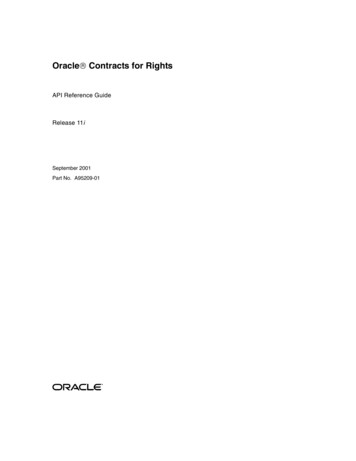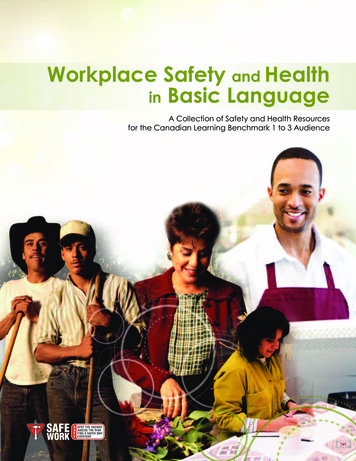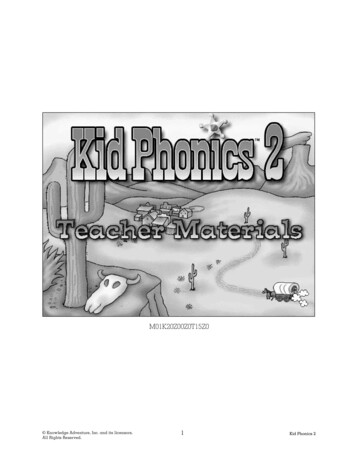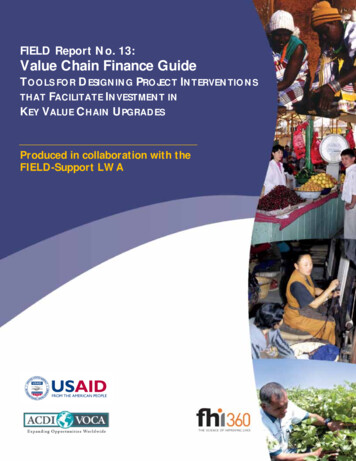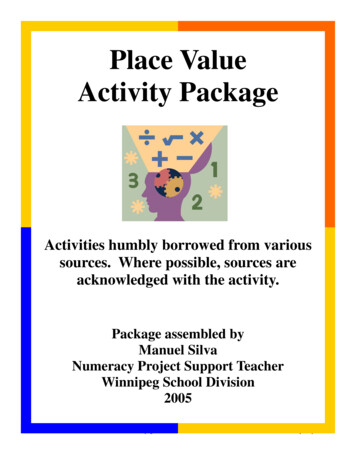
Transcription
1Place ValueActivity PackageActivities humbly borrowed from varioussources. Where possible, sources areacknowledged with the activity.Package assembled byManuel SilvaNumeracy Project Support TeacherWinnipeg School Division2005Place Value ActivitiesWinnipeg School DivisionNumeracy Project
Place Value2 Whole number vertical computational algorithms have negative effects on thedevelopment of number sense and numerical reasoning. (Kammi, 1994, Vince Wright 2000) The standard computational algorithms for whole numbers are “harmful” for tworeasons. First, the algorithms encourage students to abandon their own operationalthinking. Second, the algorithms “unteach” place value, which has a subsequentnegative impact on the student’s number sense (Kammi & Dominick, 1998) Place Value is extremely significant in mathematical learning. Yet students tend toneither acquire an adequate understanding of place value nor apply their knowledgewhen working with computational (procedural) algorithms. (Fuson, 1990; Jones andThornton, 1989) Students associate the place-value meanings of “hundreds, tens, ones” more in termsof order in placement than in base-ten groupings (Bendarnz and Janvier 1982) A major reason for place value lapses is the linguistic complexity of our place valuesystem in English. For example, we do not name “tens” as done in some languages(e.g. “sixty” vs. “six-tens”) (Fuson, 1990; English and Halford, 1995) Students with a weak understanding of place value have a difficult time understandingdecimals.students will often assume that “more digits” implies that a number islarger. (Heibert and Wearne, 1986) Many students never master the standard long-division algorithms. Even less gain areasonable understanding of either the algorithm or the answers it produces. A majorreason a underlying this difficulty is the fact that thee standard algorithm (as usuallytaught ) asks students to ignore place value understandings (Silver et al., 1993)As teachers of early years mathematicians we cannot ignore these glaring facts from theresearch, as well, as our own classroom observations. The time is here to change the way weare teaching students to “do” math in our classrooms. We need to stop teaching verticalprocedural algorithms in our early grades (1-2) and introduce them later on once studentshave shown clear understanding of place value, part-part- whole thinking as well as flexiblestrategies with whole number computation.This package is bursting with great ideas that have been created for use by teachers in ourDivision, to assist teachers in targeting place value instruction in an engaging andmeaningful way.I would like to thank Manuel Silva for taking the time to compile all the great resourcesthat we as teachers have been creating and using.now you have them all in one place!Enjoy using these materials.kids may not remember all the math you teach them but theywill never forget your attitude!Meagan Mutchmor K-8 Mathematics ConsultantPlace Value ActivitiesWinnipeg School DivisionNumeracy Project
3Some Thoughts on Place ValuePlace value understanding plays a key role in the primary grades. It is essential tohave a strong foundation in place value in order to achieve success in making sense ofour number system (based on the digits 0-9), counting, adding multiple-digit numbers,money and many other math skills. For this reason, it is important that place value notbe taught in isolation for a few weeks but that it be integrated all year long into the mathprogram. In fact, the National Council of Teachers of Mathematics (NCTM)recommends that all mathematics strands be taught in an integrated fashion throughoutthe year and not in isolation.When teaching place value to students, it is important to be aware of how students’developmental levels affect their understanding in place value. For example, a studentmay be able to count to 100 but may not be able to see that 23 is the same as two groupsof ten and three ones or 1 group of ten and 13 ones. They may be able to count individual items but have difficulty counting groups of objects.John Van de Walle states in his book, Elementary and Middle School Mathematics:Teaching Developmentally, that counting plays a key role in constructing base-ten ideasabout quantity and connecting these concepts to symbols and oral names for numbers.In order to develop place value concepts, activities should involve concrete models,practice using place value language orally, illustrations and symbols. The activitiesshould focus on one or more of the following three main components of place value:grouping activities, giving oral names for numbers and written symbols for the concepts.It is also necessary to help children connect place value concepts to real-world situations.Working with numbers around them at school, home and community makes learningmeaningful for the students.Jim Martland, et. al, in their book Teaching Framework in Number, outline a threelevel model for the development of base-ten arithmetical strategies.Level 1: Initial Concept of Ten. The student does not see ten as a unit ofany kind. The student focuses on the individual items that make up the ten. Studentcounts forward or backward by ones in addition or subtraction tasks involving tens. Atthis level, the student can identify numbers in the range of 1 to 10.Level 2: Intermediate Concept of Ten. Ten is seen as a unit composed often ones. The student is dependent on representations of ten such as open hands of tenfingers. The student can perform addition and subtraction tasks involving tens whenthey are presented with materials but not when presented as written number sentences.Level 3: Facile Concept of Ten. The student can solve addition andsubtraction tasks involving tens and ones without using materials or representations ofmaterials. They can solve written number sentences involving tens and ones by addingor subtracting units of tens and one.Place Value ActivitiesWinnipeg School DivisionNumeracy Project
4Number Sense and Place Value DevelopmentBased on research in Young Mathematicians at Work: Constructing Number Sense, Additionand Subtraction (Fosnot and Dolk, 2001).Early Stages of Place Value DevelopmentNumber Sense: Steps and LandmarksDevelop cardinality(final number said in count is the number of objects in the set)Conservation of number (one-to-one correspondence)Subitization to 5Part/whole relationships (5 and 1 are parts of 6 because they contribute to the 6)Compensation (other ways of making the same number)Counting onPlace ValueStudent recordings of their work Sporadic drawings with no attempt to represent the quantity One-to-one correspondence in the pictures to the real object Iconic (symbols) representations to represent the quantity of the objects Symbolic representation of the quantity using one symbol (a number)Once students have developed the concepts of cardinality, one-to-one correspondence,part/whole relationships and compensation, they will begin to see the need for an organized wayto keep track of their counting, especially of larger groups of objects. They will begin toorganize their counting into groups of five or ten. After working with this concept many times,they will begin to understand that ten objects can be represented as one ten. Students need todevelop the concept that one group of ten equals ten units within that group. This is calledunitizing (using a number to count not only objects but also groups). This must be in placebefore students can understand place value. They can then start to work with the concepts ofmaking 10s (8 and 2 make 10, 7 and 3 make 10) and breaking numbers apart (26 is 20 and 6and eventually, 26 32 [20 30] [6 2]).Place Value ActivitiesWinnipeg School DivisionNumeracy Project
5SubitizingThe ability to subitize is a precursor to place value understanding.Subitizing is the ability to recognize dot arrangements in different patterns.Since children begin to learn these patterns by repetitive counting they are closelyconnected to their understanding of the particular number concept. Quantities up to 10can be known and named without the routine of counting. This can help children incounting on (from a known patterned set) or learning combinations of numbers (seeinga pattern of two known smaller patterns).Young children should begin by learning the patterns of dots up to 6. Students shouldalso associate the dot patterns to numbers,numerals, finger patterns, bead strings, etc. You can then extend this to patterns up to10 when they are ready.Subitizing is a fundamental skill in the development of number sense, supporting thedevelopment of conservation, compensation, unitizing, counting on, composing anddecomposing of numbers.For example:We want children to learn that there are 5 dots in this pattern or arrangement; five is more than four; a set of 5 objects can be separated into a set of two objects and a set of threeobjects, etc.; five counters, no matter how arranged, still retains the same numerical quantity; the associated oral name for a set of five things is “five”; the numeral corresponding to a set of five objects is “5”.More subitizing online at: www.wsd1.org/pc mathPlace Value ActivitiesWinnipeg School DivisionNumeracy Project
6Subitize, SubitizeSubitize, Subitize,Seeing sets ofdifferent size.Sets of 3, sets of 5,It’s lots of fun tosubitize!Sets of 4 and sets of 2,Let me subitize withyou.Sets of 6 and sets of 4,Let us subitize somemore.Subitize, subitize,Seeing sets of differentsize.By Linda BoughtonPlace Value ActivitiesWinnipeg School DivisionNumeracy Project
7Sense of Number?Place izeNumberRelationshipsCreated by Meagan MutchmorPlace Value ActivitiesWinnipeg School DivisionNumeracy Project
8Some Activities to Further Develop Place ValueCounting Forward and BackwardCounting forward and backward helps to develop rote number patterns. Childrenshould have the opportunity to count forward and backward in multiples of 1, 2, 5,10, 3, 4 as well as from random starting points. They can count numbers in thedecades, centuries or millenniums.Number PatternsBeing able to identify number patterns on the hundred chart and addition/multiplication charts expands a child’s knowledge of number sense. Manyopportunities to explore number patterns helps students to solidify this knowledge.Counting by multiples is a counting pattern that is essential for the understandingof multiplication concepts.MoneyMoney is a great way to learn about place value and trading appropriate coins.Concepts such as fractions and decimals can also be taught through the use ofmoney.2– and 3– Digit Addition/SubtractionGood place value concepts and number sense will foster good understanding ofaddition and subtraction concepts.Place Value ActivitiesWinnipeg School DivisionNumeracy Project
9Show with base 10 blocks [younger groups can use 10 frames]The number just before is .10 more than this number is .Write in expanded notation .This number is odd/even .10 less than this number is .The number just after is .Write out in words .3 other ways to make this number are:This number is a multiple of .25 more than this number is .Start at today’s number and count by 5’s ten times.Created by Meagan MutchmorPlace Value ActivitiesWinnipeg School DivisionNumeracy Project
10More Number of the DayRoll dice to determine three digits(for example 562:)The greatest number you can make byrearranging them is 652. The smallest number you can make is 256. Add the digits together.(5 6 2 13). Multiply them (5x6x2 60). Count up in tens(562, 572, 582, 592, 602 and so on). Count down in tens(562, 552, 542 and so on). Count up in hundreds(562, 662, 762, 862, 962, 1062 etc.). Count down in hundreds(562, 462, 362, 262, 162, 62). Subtract the numbers (5-6-2 -3). Divide it by tens(562, 56.2, 5.62, 0.562, 0.0562 and so on). Multiply by ten(562, 5,620, 56,200, 562,000 and so on). Created by Meagan MutchmorPlace Value ActivitiesWinnipeg School DivisionNumeracy Project
11Number of the Day ChartShow/draw using materials,money, blocks etc.Base ten sforrepresentingthe numberNumber of theDay inNumeral form35Create apicturestoryWords: Thirty fiveShow on ten frames or drawanother representation, digiblocks, bean sticks, bundles ofstraws, etc.Note : this is just a starter of ideas to use. You can change any of the boxes to suit yourstudents and grade level.Place Value ActivitiesWinnipeg School DivisionCreated by Meagan MutchmorExpanded NotationNumeracy Project
12Flip and Fold Use Flip and Fold cards to help your students learn their number relationshipsas well as learn to “Bridge to Ten” Create cards on construction paper and then mac-tac or laminate to protectthem. Different Flip and Fold cards can be made to go with your thematic units, usestickers or copied pictures to make more variety. These cards can be a great take home game that students create on their own.Use potato prints as a art activity or bingo dabbers. Parents could also makethem at a parent function and then use them with their children.Source: Meagan Mutchmor, Math Consultant, WSDPlace Value ActivitiesWinnipeg School DivisionNumeracy Project
13Go 10Materials: 3-4 players1 deck of cards, minus the face cardsAce 11.2.3.Deal out all the cards. The game is played like Fish, exceptthat each player is trying to make 10.Each pair of cards that makes 10 is placed face up in front ofthe player who makes it.The winner is the player with the most pairs when no more10s can be formed.LeftoversMaterials: 2 players1 deck of cards, no face cards25 bingo chips1.2.3.4.5.Place Value ActivitiesOne player deals half the cards to each player.Both players turn over their top two cards.Each player determines how close the total of their cards is toten.The player whose total is closest to ten gets a chip. Ties areboth rewarded a chip.The game is over when the chips are gone. The winner is theperson with the most chips.Winnipeg School DivisionNumeracy Project
14Making TensMaterials: 2 players5 or more regular dice10 bingo chips, or any other counter1.2.3.4.One player rolls all the dice and makes groups of ten with thenumbers rolled. The total points left over after making tensis remembered by the player.The second player takes a turn.The player with the least leftover points wins the round andtakes one bingo chip.The game is over when the chips are gone. The winner is theperson with the most chips.Knock KnockMaterials: 2-4 players1 deck of cards10 counters1.2.3.4.5.6.7.Place Value ActivitiesAces are worth 1; face cards are worth 10.Each player is dealt 4 cards, and the remaining cards becomethe draw pile.The players take turns taking the top card from the draw pile,and discarding one of the cards in their hand.They are trying to make the greatest possible total value.When one player thinks he/she has the largest total, he/shesays Knock, Knock. Everyone else has one more turn.Players then add their totals. The winner takes one counter.The game is over when counters are used up.Winnipeg School DivisionNumeracy Project
15In Between GameMaterials: 3 students12, 20 or 30-sided die for each student30 bingo chips1.2.3.4.5.6.Each student rolls a die without the other students seeing thenumber rolled.Each student, in turn, tries to predict whether they have thelowest, highest or in between number.After hearing all the predictions, they may change theirprediction.Students show their number.Each student who was correct receives a bingo chip.The winner is the first child to get 10 chips.Race to 10/100/1 000Materials: 2-4 players1 000, 100 or 10 place value mats6, 20, or 30-sided diceBase ten materials – units (1), longs (10), flats (100) andblocks (1 000)1.2.Students roll die and the highest number goes first.Students play in turn by rolling the die and taking theappropriate amount of units, longs, flats, etc.e.g. a roll of 19 1 long (10) and 9 units (1s)3.4.Students continue and make appropriate exchanges asneeded.The winner is the first to reach the targeted number: 10, 100or 1 000.Variations: Start with 10, 100 or 1 000 and subtract the roll.Grades 4 may race to 10 000 or use decimalnumbers.Place Value ActivitiesWinnipeg School DivisionNumeracy Project
16Guess My NumberMaterials: Hundred Chart pocket chart or an overhead of a Hundred Chart1.Pick a secret number from the hundred chart and don’t tell thestudents what it is.Have students ask you questions to try and guess what thenumber is? Sample questions include: is it more than/lessthan, odd/even, a multiple of , end in , have tens/units,etc.Cross off numbers on the overhead chart or flip them on thepocket chart as they are eliminated by student questions.Use a tally to keep track of how many guesses it takes theclass before they identify the secret number. Next time youplay, try to beat that number of guesses.2.3.4.Extensions: Students may play the game in partners or small groups. Use hundred charts in the various centuries.What’s Your Number?Materials: 3 diceRecording sheet1.2.3.4.5. Place Value ActivitiesRoll the 3 dice.Arrange all three in order to make 6 different numbers.e.g. 3 2 6326, 263, 632,362, 236, 623.Record your numbers as in the example above.Order your numbers from least to greatest.Show your numbers usingpicturesstandard notationexpanded formWinnipeg School DivisionNumeracy Project
17NameDateWhat’s Your Number?Record your 3 numbers from the dice.Make 6 different numerals using them.Order the 6 numerals from least to greatest., , , , , .Draw a picture to show 1 of these numerals.Write the numeral using standard notation.Write the numeral in expanded form.Place Value ActivitiesWinnipeg School DivisionNumeracy Project
18Hidden Number GameMaterials: Whole class/small group/individualOverhead projectorBase ten blocksMagic cloth1.Show the students part of an equation while part ofthe equation is hidden.6 2. orStudents determine the answer.Variation: Show students part of an equation.e.g. 11 ? My number is 45. What is my hidden number?Place Value ActivitiesWinnipeg School DivisionNumeracy Project
19Five Tower GameMaterials: 2 playersUnifix cubes2 dice1 copy of the Recording Sheet per student1.2.3.4.5.6.7.Roll the dice and take that many cubes.Snap them into a tower.Take turns doing this with your partner until you each have 5towers.Each player snaps his/her own 5 towers together into a train.Compare your tower with your partner’s. Whose is longest?How much longer?Each partner now breaks his/her own train into tens andones.Record your results on the recording page.Source: A Collection of Math Lessons by Marilyn BurnsPlace Value ActivitiesWinnipeg School DivisionNumeracy Project
20NameDateFive Tower GameMy train is cubes long.My partner’s train is cubes long.Whose train is longer?How much longer is it?I have tens and ones in my train.Total cubesMy train is cubes long.My partner’s train is cubes long.Whose train is longer?How much longer is it?I have tens and ones in my train.Total cubesPlace Value ActivitiesWinnipeg School DivisionNumeracy Project
21Number Pattern Detectives*Use of a vertical number line provides a powerful visual representation of place valuenumber patterns which facilitates numerical understanding.Materials: Chart paper-sized graph paper cut into strip (vertical number line),2 or 3 columns across or adding machine tapeOverhead projectorBase 10 blocks—tens and onesPermanent black marker1.2.3.4.5.6.7.Show students the vertical number line that you have prepared.Divide students into pairs and number each student as 1 or 2.Have a pair of students come up to the overhead and have partner 1add 1 cube to the overhead. Partner 2 records the number on thevertical number line, either starting at the top or bottom of the line.Continue bringing up pairs and having partner 1 add 1 cube andpartner 2 record the new number. Partner 1 makes any trades asnecessary.When all pairs have come up, have the partners change roles andcontinue the activity.When all pairs have come up a second time, stop the activity andhave the students look for patterns on the vertical number line. Ifstudents identify repeating patterns, loop the repeating sequence,one colour for the ones place and one colour for the tens place.Complete the number line another day, beginning where it stopped.Extensions: You may wish to continue to 100 or beyond.Students may wish to make their own vertical number line and loopthe patterns they see.Have students record the counting sequence on an empty 10 x 10grid and see if there will be patterns to loop and then compare thetwo tools.Created by Manuel SilvaPlace Value ActivitiesWinnipeg School Division00010203040506Numeracy Project
22The Closest OneMaterials: 2-4 players1 deck of cards without face cards, 10 0Paper and pencil1.2.3.4.5.6.7.Deal the cards to all players.Each player will turn over two cards from their pile.Before doing this, each player predicts what they think the 2 digitnumber they can create might be.Players then turn their top two cards and create a 2 digit number(i.e. 2, 7 can be 27 or 72).Players calculate how close they are to their prediction.The player who is the closest to their prediction receives 1 point.The winner is the first player to reach 5 points.Source: Les éditions de la Chenelière Inc.Pick the Place!Materials: 2 playersPaper clip, pencil, spinnerPaper1.2.3.4.5.6.Players divide the paper in half and each one signs his/her name onthe top of their half.Each player then draws four blank spaces on their side of the paperon which they will write the digits they spin. You can adapt thegame by having students draw two or three blank spaces.One player spins the spinner and writes that digit in a chosen blank.If the spinner lands between two numbers, he chooses eithernumber.The players alternate turns until each player forms a four-digitnumber.Each player states his number. If they are identical, the round is adraw. Otherwise, the player with the larger number draws theappropriate inequality symbol between the numbers and earnsone point.Play continues until one player earns five points and is the winner.Source: The Mailbox Magazine, Primary Aug./Sept. 2003Place Value ActivitiesWinnipeg School DivisionNumeracy Project
23Pick the Place! SpinnerPlace Value ActivitiesWinnipeg School DivisionNumeracy Project
24Number ScrabbleMaterials: 2 to 4 playersHundred Chart (any century)One set of cut out numbers to match hundred chart1.2.3.4.5.Each player picks up 7 numbers and places them in front of themso that they are not visible to the other players.Each player in turn places a number anywhere on the chart,In the next, and all other rounds, the number must be placed beside,above or below (diagonal to the number is accepted as well) one ofthe numbers already on the board.If the player cannot place a number, then another must be drawnfrom the pile and play passes to the next player.The first player to put all of his or her numbers on the board is thewinner.Source: Manitoba Education and Training ity games.htmlHundred Chart PictureMaterials: 10 x 10 GridCrayons12.3.4.Colour a picture using different colours on the hundred chart youwish to work with.Each student gets a hundred chart in a predetermined range.Ask students to colour certain number boxes in specific colours,one number at a time and not in sequential order.When finished, the student should have an identical picture to theteacher’s.Extension: This activity can also be done by providing students with writteninstructions as to which numbers to colour in each colour. Use any 10 x 10 grid with varying number ranges such as 501 to600 or 351 to 450.Place Value ActivitiesWinnipeg School DivisionNumeracy Project
25Hundreds Chart Tic-Tac-ToeLevel:Skills:Players:Equipment:Grade 2 and upIdentification of place value 1—10021 hundreds board, cards (Ace 1) - 9, paper, pencil, markers(2 different colours)Getting Started:Players select a colour of marker. The goal of the game is for aplayer to get three or more of their markers in a row eithervertically, horizontally or diagonally. Player number one begins bydrawing two cards and making this number to their partner: i.e.draw 6, 3 and says “six tens and three ones equals sixty-three”.Player number one then covers this number with their marker.Then this player verbally gives the other number that they canmake with their two cards (i.e. thirty-six) and covers that number.Player number two then takes a turn, drawing two cards andcovering both numbers, remembering to verbalize the tens andones place value to the other player. Play continues until oneplayer gets three or more of their markers in a row. When thishappens, this player scores two points for each marker in a row(i.e. six points for three in a row, eight points for four in a row, andso on).Players can also steal an opponent’s space. When a player makes anumber already occupied by their opponent, they can replace itwith their own marker. For each number stolen, they receive fivepoints.If a player draws two cards that they have already drawn, two newcards may be taken.Players can play until a set time limit is reached or they reach acertain number of points.Source: Math Games for Kids Using Special Dice by Joanne Currah and Jane FellingPlace Value ActivitiesWinnipeg School DivisionNumeracy Project
26Hundred ated by M. SilvaPlace Value ActivitiesWinnipeg School DivisionNumeracy Project
27101-200 Hundred 49 200Created by M. SilvaPlace Value ActivitiesWinnipeg School DivisionNumeracy Project
28201-300 Hundred 49 300Created by M. SilvaPlace Value ActivitiesWinnipeg School DivisionNumeracy Project
29301-400 Hundred 49 400Created by M. SilvaPlace Value ActivitiesWinnipeg School DivisionNumeracy Project
30401-500 Hundred 49 500Created by M. SilvaPlace Value ActivitiesWinnipeg School DivisionNumeracy Project
31501-600 Hundred 49 600Created by M. SilvaPlace Value ActivitiesWinnipeg School DivisionNumeracy Project
32601-700 Hundred 49 700Created by M. SilvaPlace Value ActivitiesWinnipeg School DivisionNumeracy Project
33701-800 Hundred 99800Created by M. SilvaPlace Value ActivitiesWinnipeg School DivisionNumeracy Project
34801-900 Hundred 99900Created by M. SilvaPlace Value ActivitiesWinnipeg School DivisionNumeracy Project
35901-1 000 Hundred 991000Created by M. SilvaPlace Value ActivitiesWinnipeg School DivisionNumeracy Project
36Blank Hundred ChartCreated by M. SilvaPlace Value ActivitiesWinnipeg School DivisionNumeracy Project
Base ten blocks are abstract and should only be introduced in grade 3 or 4 once students demonstrate an understanding of place value concepts.Place Value ActivitiesWinnipeg School Division37Numeracy Project1 to 100 Base Ten Hundred Chart(Base ten bl
Money Money is a great way to learn about place value and trading appropriate coins. Concepts such as fractions and decimals can also be taught through the use of money. 2– and 3– Digit Addition/Subtraction Good place value concepts and number sense will foster
